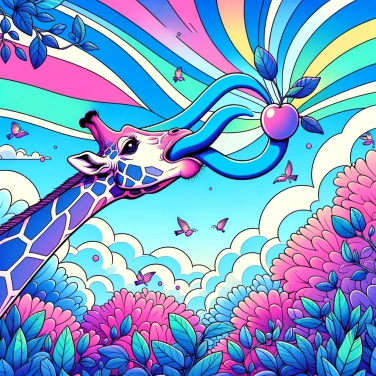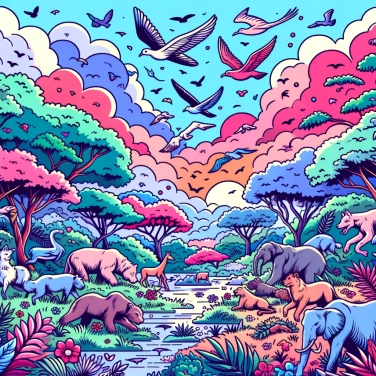The long, blue tongue of giraffes allows them to more easily reach the leaves of thorny trees, their main source of food, while protecting themselves from thorns. The blue color of the tongue is due to the high concentration of blood vessels, which help regulate body temperature when they feed in direct sunlight.

Giraffes have not always had such an impressive tongue. Over time, natural selection has favored individuals capable of reaching food at higher levels, where competition is less fierce. Having an extra-long tongue allowed them to better grasp leaves high up in acacias. Gradually, giraffes with the most effective tongues survived better, giving rise to a species with a tongue that can measure up to 50 centimeters! This gradual evolution is a perfect example of biological adaptation to the environment and food competition.
Having a very long tongue (up to 50 cm!) is particularly useful for giraffes to easily access their favorite food: acacia leaves. These trees often have foliage that is high up and far between thorny branches. Thanks to their agile and exceptionally long tongue, giraffes can wrap it around the branches to easily grab those leaves. It’s a bit like having a hand integrated into their mouth: they simply stretch their long tongue to catch the most tender and hard-to-reach shoots. Convenient, right?
The bluish or dark coloration of the giraffe's tongue acts as a natural sunscreen. Its dark hue is due to a high concentration of melanin, the pigment found, for example, in your tanned skin. Indeed, this melanin effectively protects against sunburn during long days of licking leaves high up under intense sun. Moreover, a dark tongue means a suitable blood circulation to prevent burns and prolonged exposure to UV rays. Thanks to this, the giraffe can peacefully munch in the blazing sun without risking its skin.
The language of giraffes works a bit like a dexterous hand that protects them from the sharp thorns of acacias and other trees on which they feed. Thanks to its hard yet flexible layer, this tongue delicately grabs leaves between the thorns without getting hurt. Its exceptional length allows it to navigate around dangerous points and reach tender shoots located amidst the thorns without pricking itself. It's a bit like their natural "protective glove," effective even against pesky or irritating insects hidden in the foliage.
Although subjected to harsh conditions daily, the giraffe's tongue has a very durable and regenerative coating, allowing it to avoid injuries from the sharp branches and thorns it constantly encounters.
Giraffes spend about 16 to 20 hours a day foraging for and eating food; their agile tongues allow them to conserve precious energy and optimize their daily intake.
The dark blue color of giraffes' tongues comes from a high concentration of melanin; this pigment helps protect the tongue from sunlight, thus preventing sunburn when the animal feeds for hours under intense exposure.
Despite their imposing size, giraffes sleep only between 10 minutes and 2 hours a day, most often in very short bursts of just a few minutes.
The tongue of giraffes typically measures between 45 and 50 cm in length. This impressive size allows them to effectively grasp leaves located high up and between the thorns of trees, particularly acacias.
No, the tongue of giraffes is particularly well-suited to this challenging diet. It is very strong, flexible, and covered with a tough layer, which allows them to handle thorny foliage without injuring themselves.
Yes, they use their tongues for various reasons, such as grooming their nostrils, cleaning their ears, or establishing positive social interactions with other giraffes by licking them.
Indirectly, yes. The length of the tongue accompanies the general morphological evolution of the giraffe, which is designed to reach food placed at height. Their long neck and long tongue work together to increase the giraffes' reach to the leaves located at the tops of trees.
Yes, most giraffes have a dark blue to black tongue, but the exact shade can vary slightly depending on the individual and age. This dark coloration helps protect their tongue from the sun's ultraviolet rays.

0% of respondents passed this quiz completely!
Question 1/6